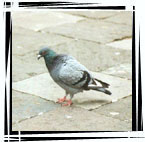|
|
The only native pigeon to North America is the Band-tailed Pigeon. The city pigeon, known by some as the Rock Dove, was brought over by European settlers in the early sixteen hundreds. Escaped or released pigeons established themselves in settlements and towns around humans because of the abundant food supply. They can now be found in most areas of North America, and throughout the world, except in the forests and mountains Pigeons build a rather flimsy nest of twigs on a ledge or recessed area, and lay one or two eggs. They hatch after eighteen days. Nestlings are fed a regurgitated liquid known as pigeon's milk, by both parents. The young pigeons leave the nest in four to six weeks. Pigeons feed primarily on seed, grain, garbage, greens and insects. They can live up to fifteen years, but because of disease; poisonings, and accidents, life expectancy in the cities is three to four years.   Note the differences between a Band-tailed Pigeon
(left) and a Rock Dove (right). Note the differences between a Band-tailed Pigeon
(left) and a Rock Dove (right).Coloration differences, like the yellow feet of the Band-tailed Pigeon
vs the Rock Dove's pink feet, are what helps distinguish between the two birds. Preventing
a problem Tips: If
you have pigeons in your neighborhood make sure there is no access to your
attic. This will also keep out other unwanted visitors. If
pigeons are investigating a recessed area under your eaves, apply scare
tactics or screening immediately, before they decide to stay and nest. Do
not feed them, allow them to forage naturally. Their population will remain
more stable if they are not overfed. Enjoy watching pigeons without
encouraging a problem by becoming a provider. Solving
a problem How
do I deal with pigeons on my roof? Life-like
statues of owls are available through garden supply catalogs. They should be
mounted on a stick so they move slightly in the breeze. The owls should be
moved periodically so the pigeons won't become accustomed to them. Balloons,
shiny strips of foil or plastic tied on posts or a line can be an effective
scaring device. These may be removed after the pigeons have settled some where
else. What
do I do with pigeons that are nesting in my attic? Screen
the entry point to eves and attics so the birds do not have access. You can
use a clear plastic bird netting available at garden supply stores. Galvanized
hardware cloth or aviary wire may also be used. Be sure all birds are out
before screening the area. How
do I prevent nesting on ledges of my building? Altering
the angle of the flat surface will keep them off. This can be done with
sheeting, concrete or wood installed at a 45-60 degree angle. String
mono-filament line above the surface where the pigeons land. It can be
attached with eyelet screws. The line should be taut, so it will not collapse
under the weight of the bird when it attempts to land. Slinky
toys purchased at a toy store work well for altering ledges. Attach the Slinky
at one end and stretch it along the ledge, being careful not to open it all
the way. The objective is to make it uncomfortable for the pigeons to land. Hang wind chimes that move and make noise.
|